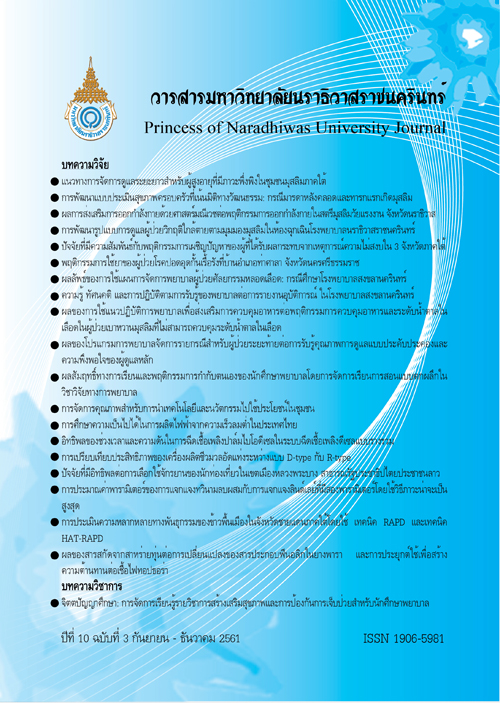Dying Critically Ill Patients: A Caring Model Development based on a Muslim Perspective in Emergency Room, Naradhiwasrajanakarindra Hospital
Keywords:
Caring model for dying critically ill patient, Muslim perspective, Participation of Muslim family member, Management for dead patientAbstract
This action research aimed to develop a caring model for dying critically ill patients in Emergency
Room (ER), based on a Muslim perspective, in Naradhiwasrajanakarindra hospital. The participants of this
study were 25 ER nurses and 30 Muslim family members of the dying critically ill patients in emergency room, Naradhiwasrajanakarindra hospital. Framework of this caring model integrated the manual for cardiopulmonary resuscitation (CPR) by Thai Resuscitation Council, as well as customs and rites of Islam. Main instruments were: 1) a checklist in using the caring model for nurses, 2) a checklist in using the caring model for family members, and 3) a questionnaire regarding satisfaction toward the using of caring model. They were tested for reliability of psychometric properties with Pearson correlation (0.83), and with Cronbach’s alpha coefficient both for the family members (0.84) and the registered nurses’ satisfaction (0.75).
Results indicated that the caring model was congruent with Muslim perspective, and this, from the
preparation step for CPR to the step of allowing family members to recover the human remains. In conclusion, the model integrates proper CPR practice, and Muslim traditions for dying critically ill patients in emergencyroom, in all respect for the spiritual and religious dimensions.
References
Campinha-Bacote, J. (1999). Amodel and instruments for addressing cultural competency in healthcare. Journal of Nursing Education, 38(5), 203-207.
Dangsuwan, K., Gaseng, S., Ratttanasakul, R., Majae, B, & Yunu, O. (2011). Conference proceeding for Caring the life-threatening patients based upon Muslim Perspective in emergency room Naradhiwasrajanakarindra hospital, the 14th National Nursing Conference, 14-19 November 2011. Bangkok: The Nurse’s Association of Thailand. (in Thai)
Department of Emergency, Naradhiwasrajanakarindra Hospital. (2016). Annual Report 2016. (Mimeographed). (in Thai)
Department of Health Service Support. Ministry of Public Health. (2006). Manual of postmortem investigation. Nonthaburi: The Agricultural Co-operative Federation of Thailand.
Ezenkwele, U., & Roodsari,G.S. (2013). Cultural competency in emergency medicine: Caring for Muslim-American patients from the Middle East. The Journal of Emergency Medicine, 45(2), 168-174.
Hasuwannakit, S. (2009). Attitude toward death and caring for end-stage patient based on Muslim perspective. In P.
Suthirawut and N. Yusuf (Ed.). Management Health Service based on Muslim Perspective for four age-groups: children, adolescent, adult, end-stage patient. (2nd ed). 59-77. Songkhla: Health System Management Institute. Songhkla. (in Thai)
Institute of Hospital Accreditation. (2015). Hospital Standard and Healthcare Services to Cerebrate the 60th Anniversary of His Majesty to the Throne. Bangkok: Deewan. (in Thai)
Japakeeya, I. (2012). Manual for Patient and Management based on Islamic Religion. (2nd ed.). Nonthaburi: First Offset 1993. (in Thai)
Kemmis, S., &McTaggart, R. (1988). The action research planner. (3nd ed.). Victoria, Australia: Deakin University Press.
Kennedy, G. (2016). The importance of patient dignity in care at the end of life. Ulster Medical Journal, 85(1), 45-48.
Kongsuwan, W., Nilmanat, K., & Matchim, Y. (2014). Obstacles in caring dying patient at emergency room: experiences of nurses. Journal of Sonklanagarind Nursing, 34(3), 97-108.
Neema, Y. & Hasuwannakit, S.(2008). Medicine and Caring for Patient based on Muslim Perspective. Health System Management Institute. Songhkla. (in Thai)
Norasan, S. (2014). Emergency trauma nursing. Conference proceedings for the emergency trauma nursing, 2-6 June 2014 Bangkok: Division of Nursing service and Continuing Education in Nursing, Ramathibodi School of Nursing, Faculty of Medicine, Mahidol University. (in Thai)
Proctor,B. (2001). “Training for the Supervision Alliance Attitude, Skill and Intention.” In J.R. Cutcliffe, T. Butterworth,
& B. Proctor, (eds). Fundamental Themes in Clinical Supervision. London: Routledge, 25-46.
Ratttanasakul, N. & Dangsuwan, K. (2016). Development of caring system for patient with life-threatening in emergency department, Naradhiwasrajanakarindra hospital. Princess of Naradhiwas University Journal, 8(2), 1-15.
Sheikhul Islam Office and National Human Rights Commission of Thai (2012). Guideline for Post-mortem Investigation based on Forensic Sciences and Muslim Perspective. National Human Rights Commission of Thai. Bangkok. (in Thai)
Tayeb, M.A., Al-Zamel, E., Fareed, M.M., & Abouellai, H.A. (2010). A good death: Perspectives of Muslim patients and health care providers. Annuals of Saudi Medicine, 30(3), 215-221.
Thai Resuscitation Council. (2015). Highlights of 2015 guidelines update for CPR and ECC. Bangkok: Panyamite Publishing.
Tse, J.W.K., Hung, M.S.Y., & Pang, S.M.C. (2016). Emergency nurses’ perceptions of providing end-of-life care in a Hong Kong Emergency department: A qualitative study. Journal of Emergency Nursing, 42(3), 224-232.
Uhasuit, K. (2016). Trauma Nurse Coordinator. Proceeding for TNCS: Trauma Care and Outcomes. 18-19 February 2016. Bangkok: Department of Medical Service and Division of Surgical Trauma, Faculty of Medicine, Siriraj Hospital. Mahidol University and Royal College of Surgeonsof Thailand. (in Thai)
Yousefi, H. & Abedi, H.A. (2011). Spiritual care in hospitalized patients. Iranian Journal of Nursing and Midwifery Research, 16(1), 125-132.




